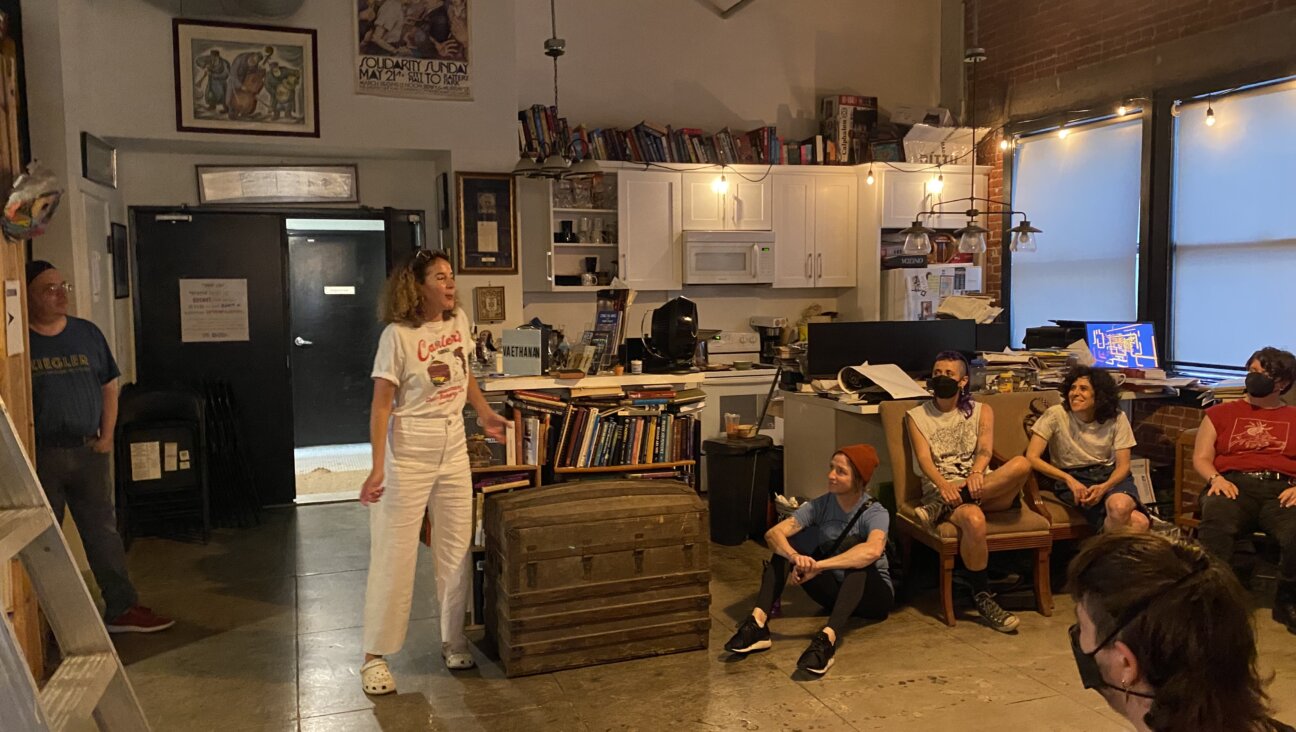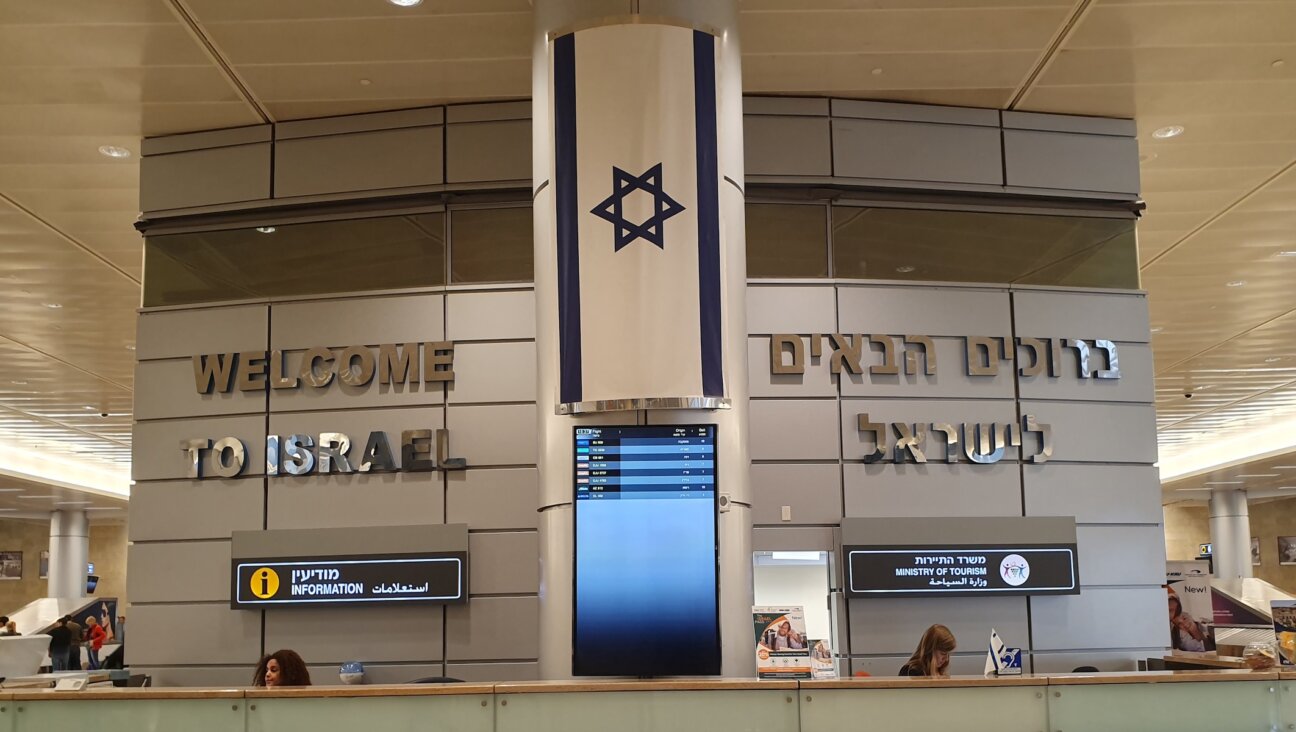Religious Zionists Feel Anger, Alienation As Israel’s Political Map Shifts Leftward
In a historic photo that serves as an icon of Orthodox settlers’ political clout, Menachem Felix is held aloft by supporters, his face staring at the camera in amazed joy next to an oversized Israeli flag. Thirty years after that picture was taken, Felix decided not to put a flag on his house in the settlement of Elon Moreh for Independence Day, which fell on May 3.
In May 2006, Felix’s missing flag also can be seen as an icon: It stands for the ambivalence — or even antipathy — of some religious Zionists toward the State of Israel on the first Independence Day since the evacuation of the Gaza settlements. It also can been seen as a symbol of how the fortunes of the religious Zionist movement have changed as a new Israeli government takes office this week. For the first time ever, Israel is swearing in a government that is explicitly committed to dismantling more settlements on its way to a smaller Israel. It is also the first Israeli government in which religious Zionism’s political standard-bearer, the National Religious Party, once an essential partner in every government of left and right alike, was not even a plausible candidate for inclusion.
The photo of Felix, who was then 29, was taken in December 1975 in front of the abandoned train station at Sebastia, near Nablus in the West Bank. After a weeklong sit-in at the spot by Gush Emunim — a protest movement of young, right-wing religious Zionists —- the government of Yitzhak Rabin had caved in and given permission for settlers to stay in the area. Gush Emunim’s leaders were motivated by the doctrine that Israel’s establishment and its Six Day War victory were leaps toward messianic redemption, and that faith required settling all the land taken in 1967. At Sebastia, they believed they’d become the new vanguard of Zionism, setting the state’s direction. And with teenage supporters lifting the leaders on their shoulders, they danced in celebration.
At the time, the National Religious Party, with 10 Knesset seats, was a key partner in the ruling coalition — as it always had been. For the NRP, Sebastia also marked a turning point: A young generation, intent on setting a hawkish national policy, was seizing the leadership of religious Zionism from older, moderate politicians. Afterward, the party moved steadily rightward, staying in power under Likud governments. Settlement accelerated, with the Orthodox settler movement getting somewhat more of the credit, or blame, than it deserved — given that the Likud backed wide settlement, and even Labor supported settling significant parts of the West Bank.
The formation of Prime Minister Ehud Olmert’s new government shows how much has changed. The government guidelines, hammered out between Olmert’s Kadima party and Labor, call for setting Israel’s permanent borders, which “will require reducing the area of Israeli settlement in Judea and Samaria.” Olmert, the former Likud stalwart, is now committed to ensuring Israel’s Jewish majority via a pullout from much of the West Bank.
In the March election, the NRP ran together with the hard-line National Union on a joint ticket that won nine Knesset seats, of which the NRP got three — the lowest in its history. Just as significant, the National Union-NRP was virtually the only Jewish party to stay out of the swirl of coalition contacts after the election. One pro forma meeting with Olmert, NRP Chairman Zevulun Orlev said, was enough to show that “we had no interest in being partners in Olmert’s government…. We cannot support its central diplomatic program.”
In contrast to founding prime minister David Ben-Gurion’s explicit exclusion of the Communists and of Menachem Begin’s rightist Herut in Israel’s early years, Orlev stressed: “We don’t feel boycotted. We weren’t interested in joining” the coalition. “The whole political map has moved leftward.” But “religious Zionism, because its diplomatic stand is tied to religious belief, has not moved…. The Sabbath is the same Sabbath; the Land of Israel is the same Land of Israel.”
Despite political isolation and the Gaza pullout, Orlev retains the classic religious Zionist view of Independence Day as a religious holiday and of Jewish sovereignty as spiritually significant in itself. “One mustn’t confuse the state and the government,” he insisted.
But others are shifting their views. Felix — who studied in his youth with Rabbi Tzvi Yehudah Kook, Gush Emunim’s spiritual mentor — said he would say the Hallel thanksgiving prayer on Independence Day but he would not put up a flag. The flag is now a symbol that Felix connects to the “horror of coming to expel” the Gaza settlers. Until fairly recently, Felix affirmed Kook’s view that the establishment of Israel reflected “a process bringing redemption…. It’s messianic, I’m not embarrassed to say.” Now, “my certainty has been shaken.”
Allowing a similar doubt, Haifa’s chief rabbi, Shear Yashuv Cohen, has made a small change in the way in which he recites the Prayer for the State: Instead of asking God to bless Israel as “the first flowering of our redemption,” he asks for a blessing “so that it will be the first flowering….” He recalls Isaac Herzog, Israel’s first Ashkenazic chief rabbi and one of the prayer’s authors, explaining that when “houses are being built and the land is flowering, we are approaching redemption.” So when “houses are destroyed,” Cohen said, referring to the Gaza pullout, “it’s not exactly the same thing.”
While denying any such doubts, Rabbi Shmuel Eliahu said that Independence Day had become a time for “soul-searching,” which he would devote to studying the words of the prophets “Isaiah, Jeremiah, Hosea, Malachi about the state.” Eliahu, chief rabbi of Safed, is the son of Mordechai Eliahu, one of the dominant rabbinic figures in religious Zionism. The older Eliahu is known for his reported statement before the Gaza pullout, “It will not come to pass,” using a Hebrew verb form that suggested prophetic certainty. On the holiday, Shmuel Eliahu said, he would put up an Israeli flag along with an orange ribbon — the symbol of the anti-pullout camp before last August and of the embittered since then.
The bitterness is widespread. A recent poll of settlers in the Mateh Binyamin region, north of Jerusalem, found that 61% felt “disappointment and anger toward the state, the army and the police.” This figure rose to 67% in the Orthodox-dominated settlements deep in the West Bank.
At the fringes, especially among young settlers and supporters, anger has become alienation — a phenomenon that worries adult leaders. The same survey found that seven out of 10 teens did not have a respected leader or teacher whom they would “obey at a time of struggle.” At demonstrations, some teens have worn T-shirts that read, “Disengage From the State — Connect to Torah.”
The most recent issue of the settlers’ monthly Nekuda — now edited by Moty Karpel, ideologue of the radical-right Jewish Leadership movement — carried a debate on that kind of “disengagement.” One writer, Tidhar Hirshfeld of Adei Ad, an illegal outpost near Shilo, praised the “separation of the youth from the State of Israel” as “the next thing, a mission, a value,” and called for replacing the traditional prayer for the state with “a prayer for the coming of redemption, for the rise of the [messianic] kingdom.”
In the most striking expression of such “disengagement,” some young settlers have adopted the anthem of the extreme ultra-Orthodox Neturei Karta, which proclaims, “In the government of the heretics we do not believe/And their laws we will not follow.” A rock version of the song was performed last year by aging pop singer Ariel Zilber, who now identifies with the “orange” camp, in response to the Gaza pullout. Since then, the version has been heard at settler weddings.
This response is a predictable outcome of Kook’s theology. Like the anti-Zionist ultra-Orthodox, he accepted that Jews should not create a state unless redemption is nearing. But he asserted that this was happening — and after 1967 he linked redemption to territorial expansion. For products of the movement that he inspired, giving up land can therefore raise questions about both redemption and the state’s legitimacy.
Since, according to left-leaning Orthodox philosopher Moshe Halbertal, the spiritual significance of the state for Kook’s settler disciples “is not in the very idea of sovereignty but in its being applied in a territorial, messianic direction,” they in fact find it difficult to distinguish between the state and the government. Halbertal, a Hebrew University professor, adds that psychologically, many religious Zionists are interpreting the country’s shift in political direction as a deliberate attack on them, an attempt to shatter their power. The real reasons for the political shift — concerns about security and the desire to maintain a Jewish majority — are discounted.
Olmert’s plan for a new pullback would require dismantling the settlements deepest in the West Bank — the ones, such as Elon Moreh, where religious settlers are concentrated. So one of the new government’s greatest challenges will be defusing settler alienation. Felix’s decision not to raise the flag is a symbol of that challenge.
A message from our CEO & publisher Rachel Fishman Feddersen

I hope you appreciated this article. Before you go, I’d like to ask you to please support the Forward’s award-winning, nonprofit journalism during this critical time.
At a time when other newsrooms are closing or cutting back, the Forward has removed its paywall and invested additional resources to report on the ground from Israel and around the U.S. on the impact of the war, rising antisemitism and polarized discourse.
Readers like you make it all possible. Support our work by becoming a Forward Member and connect with our journalism and your community.
— Rachel Fishman Feddersen, Publisher and CEO






















